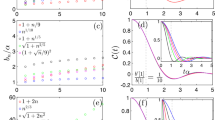Abstract
We show that quantum interference can be interpreted in terms of a phase invariant quantity, not unlike the Berry’s phase. Under this interpretation, closed loops in time become fundamental quantum entities, and all quantum states become periodic. Decoherence is then seen to occur naturally as a consequence. This formalism, although counterintuitive, provides another useful way of assigning meaning to quantum probabilities and quasi-probabilities.
Similar content being viewed by others
References
Feynman, R.P., Leighton, R.B., Sands, M.: The Feynman Lectures on Physics, vol. III. Addison-Wesley, Menlo Park (1965)
Einstein, A., Podolsky, B., Rosen, N.: Can quantum-mechanical description of physical reality be considered complete? Phys. Rev. 47, 777 (1935)
Bell, J.S.: On the Einstein Podolsky Rosen paradox. Physics 1, 195 (1964)
Kirkpatrick, K.A.: “Quantal” behavior in classical probability. Found. Phys. Lett. 16, 199 (2003)
Mermin, N.D.: The Ithaca interpretation of quantum mechanics. Pramana 51(5), 549 (1998)
Berry, M.V.: Quantal phase factors accompanying adiabatic changes. Proc. R. Soc. Lond. A 392, 45 (1984)
Resta, R.: Manifestations of Berry’s phase in molecules and condensed matter. J. Phys.: Condens. Matter 12, R107 (2000)
Loss, D., Schoeller, H., Goldbart, P.: Weak-localization effects and conductance fluctuations: implications of inhomogeneous magnetic fields. Phys. Rev. B 48, 15218 (1993)
Lyanda-Geller, Y.: Topological transitions in Berry’s phase interference effects. Phys. Rev. Lett. 71, 657 (1993)
Zhang, Y., Tan, Y.-W., Stormer, H.L., Kim, P.: Experimental observation of the quantum Hall effect and Berry’s phase in graphene. Nature 438, 201 (2005)
King-Smith, R.D., Vanderbilt, D.: Theory of polarization of crystalline solids. Phys. Rev. B 47, 1651 (1993)
Niu, Q., Kleinman, L.: Spin-wave dynamics in real crystals. Phys. Rev. Lett. 80, 2205 (1998)
Astumian, R.D.: Adiabatic operation of a molecular machine. Proc. Natl. Acad. Sci. 104, 19715 (2007)
Anastopoulos, C., Savvidou, N.: Quantum mechanical histories and the Berry phase. Int. J. Theor. Phys. 41, 529 (2002)
Griffiths, R.B.: Consistent histories and the interpretation of quantum-mechanics. J. Stat. Phys. 36, 219 (1984)
Rozanov, Y.A.: Probability Theory. Dover, New York (1969)
Bland, J.M., Altman, D.G.: Bayesians and frequentists. Br. Med. J. 317, 1151 (1998)
Weizsäcker, C.F. v.: The Structure of Physics. Springer, Dordrecht (2006)
Dirac, P.A.M.: The physical interpretation of quantum mechanics. Proc. R. Soc. Lond. 180, 1 (1942)
Knight, P.: Quantum mechanics: where the weirdness comes from. Nature 395, 12 (1998)
Dennett, D.C.: Intuition pumps. In: Brockman, J. (ed.) The Third Culture: Beyond the Scientific Revolution. Simon & Schuster, New York (1995)
Feynman, R.P.: Space-time approach to non-relativistic quantum mechanics. Rev. Mod. Phys. 20, 367 (1948)
Everett, H. III: In: DeWitt, B.S., Graham, N. (eds.) The Many-Worlds Interpretation of Quantum Mechanics. Princeton Univ. Press, Princeton (1986)
Tegmark, M.: The interpretation of quantum mechanics: many worlds or many words? Fortsch. Phys. 46, 855 (1998)
Zurek, W.H.: Decoherence, einselection, and the quantum origins of the classical. Rev. Mod. Phys. 75, 715 (2003)
Raju, C.K.: Time travel and the reality of spontaneity. Found. Phys. 36, 1099 (2006)
Gödel, K.: An example of a new type of cosmological solutions of Einstein’s field equations of gravitation. Rev. Mod. Phys. 21, 447 (1949)
Gott, J.R. III: Closed timelike curves produced by pairs of moving cosmic strings: exact solutions. Phys. Rev. Lett. 66, 1126 (1991)
Kerr, R.P.: Gravitational field of a spinning mass as an example of algebraically special metrics. Phys. Rev. Lett. 11, 237 (1963)
Carroll, S.M., Chen, J.: Spontaneous inflation and the origin of the arrow of time. arXiv:hep-th/0410270v1 (2004)
Author information
Authors and Affiliations
Corresponding author
Rights and permissions
About this article
Cite this article
Rave, M.J. Interpreting Quantum Interference Using a Berry’s Phase-like Quantity. Found Phys 38, 1073–1081 (2008). https://doi.org/10.1007/s10701-008-9252-y
Received:
Accepted:
Published:
Issue Date:
DOI: https://doi.org/10.1007/s10701-008-9252-y




